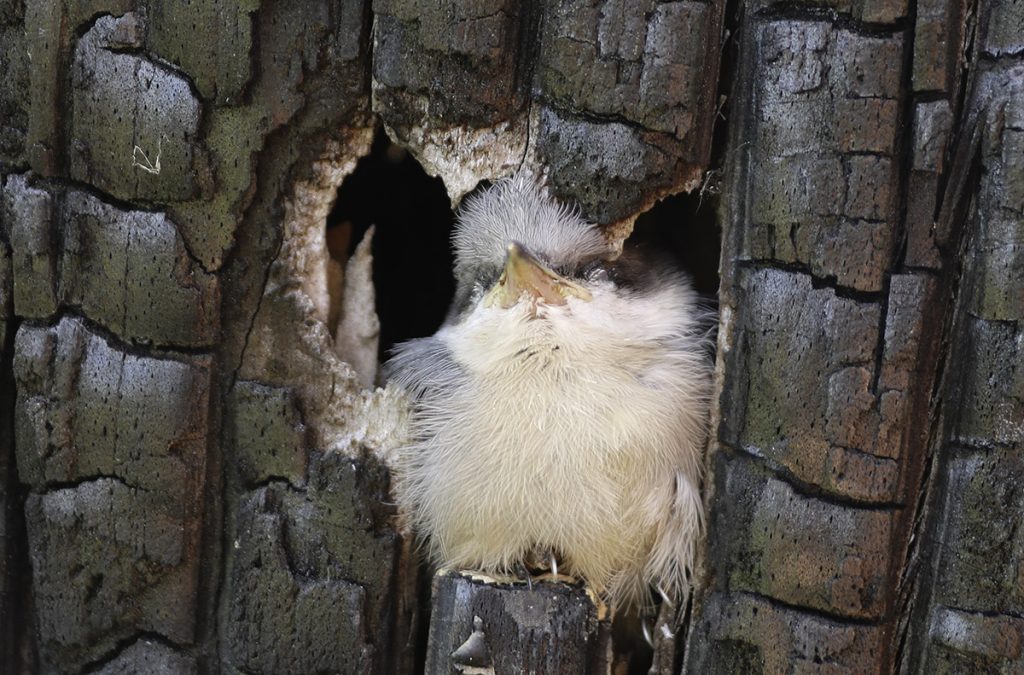Jim Cox walks up to a tall, charred pine stump and peeps into a hole. “They are not in here, dagnabbit,” Jim says. “I knew I should have done this yesterday.” This is the first of five nests we’ll check today at Tall Timbers Research Station. It’s early April, and nesting brown-headed nuthatches are getting ready to fledge throughout the longleaf pine forest.
As the Director of the Stoddard Lab at Tall Timbers, Jim has been watching these birds for twenty years. He and his team have marked and observed generations of birds, starting when they’re chicks in the nest. Jim and his team watch the birds throughout their lives, and the lives of their offspring and grand-offspring and so on.
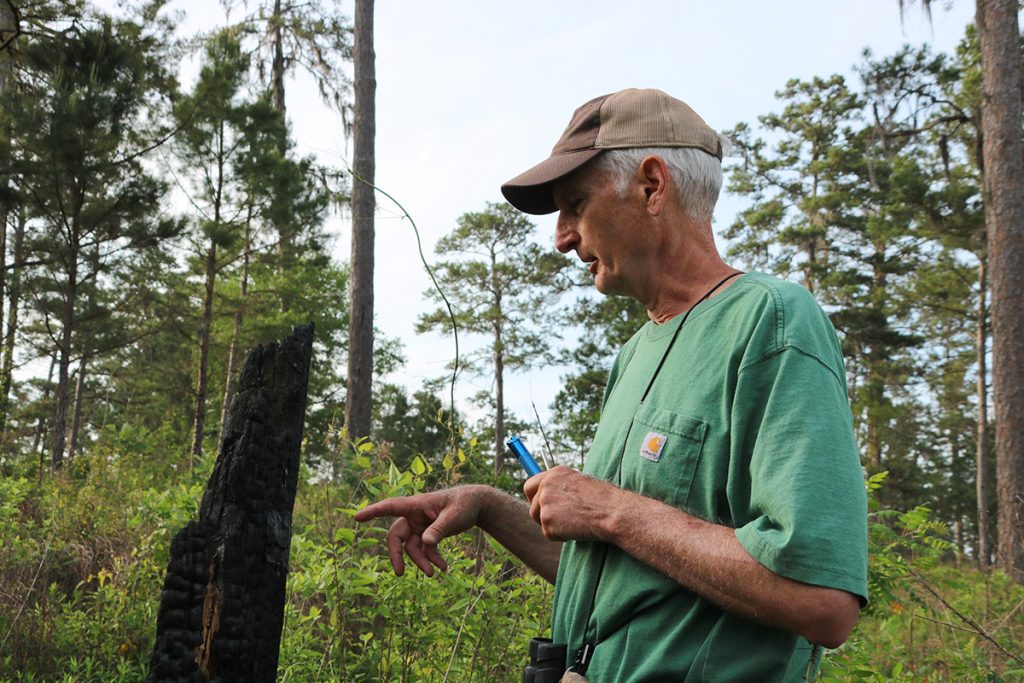
The reason Tall Timbers is paying so much attention to the brown-headed nuthatch is its family structure. This bird is a cooperative breeder, a behavior found in about ten percent of all birds. It’s not well understood.
Every year, when nuthatches fledge, some do the same as most other bird species. They head out into the world to find a mate, and make their own nest the following year. But some of their siblings stay, and help their parents with next year’s brood. Why do some leave right away, and why do others wait another year to head out? Does either path have an advantage over the other?
“One of the things when I started working here Tall Timbers and realized that this cooperative breeder hadn’t been very well studied,” Jim says, “was to think that we should have a long term study here to sort of mirror some of the work done elsewhere. And so we began just marking birds and following them through.”
Banding brown-headed nuthatches
Brown-headed nuthatches (Sitta pusilla) are small birds that forage high up in longleaf pine trees. They’re easy enough to observe when they’re nesting, as their nests are seldom higher off the ground than an average human. But observing them is one thing. If Jim wants to understand the behavior of thousands of birds over several generations, he needs to know the identity of every bird.
The nuthatches in this study represent one of the four bird species Jim bands on Tall Timbers. Two of the others, red cockaded woodpeckers and Bachman’s sparrows are, like brown-headed nuthatches, endemic to southern pinelands. That means they’re found in fire dependent longleaf pine and related ecosystems, and nowhere else. The Henslow’s sparrow is a bird that migrates from northern grasslands to the longleaf forest.
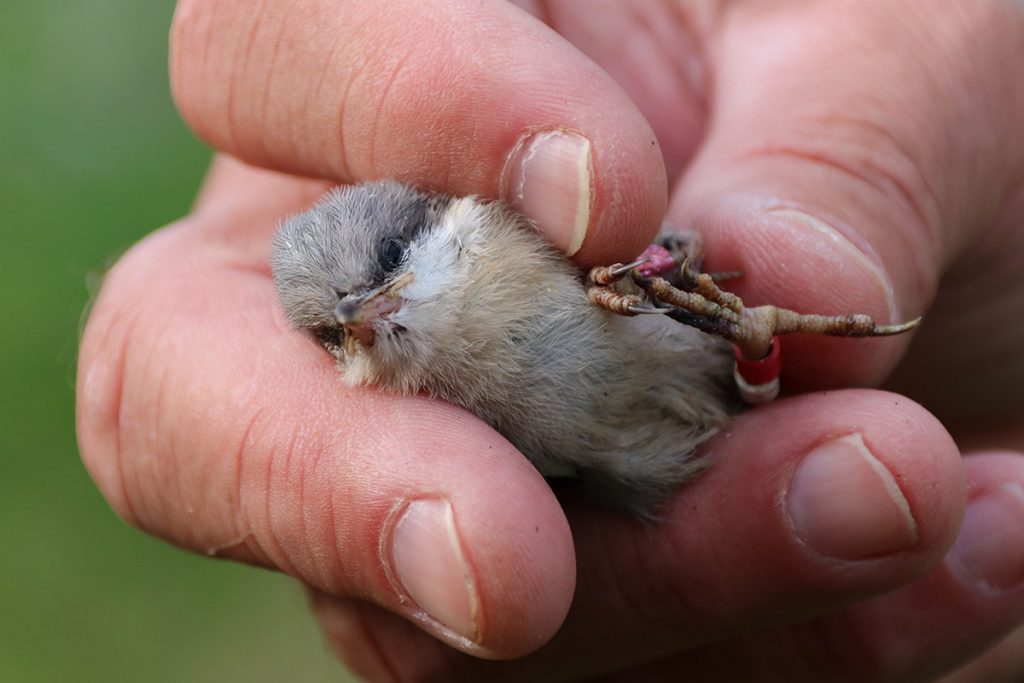
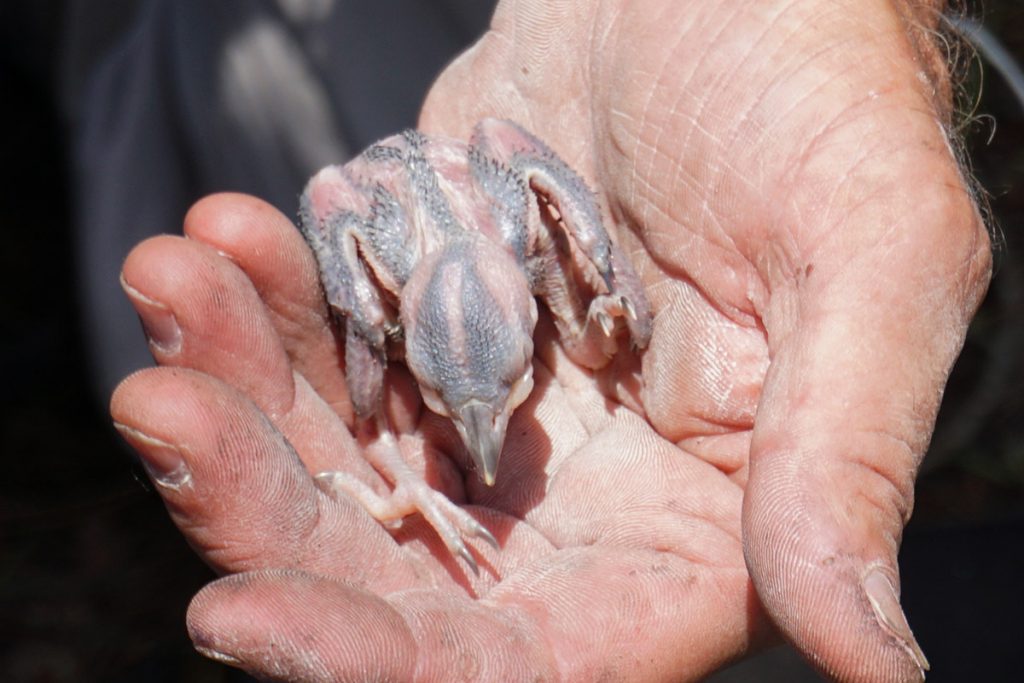
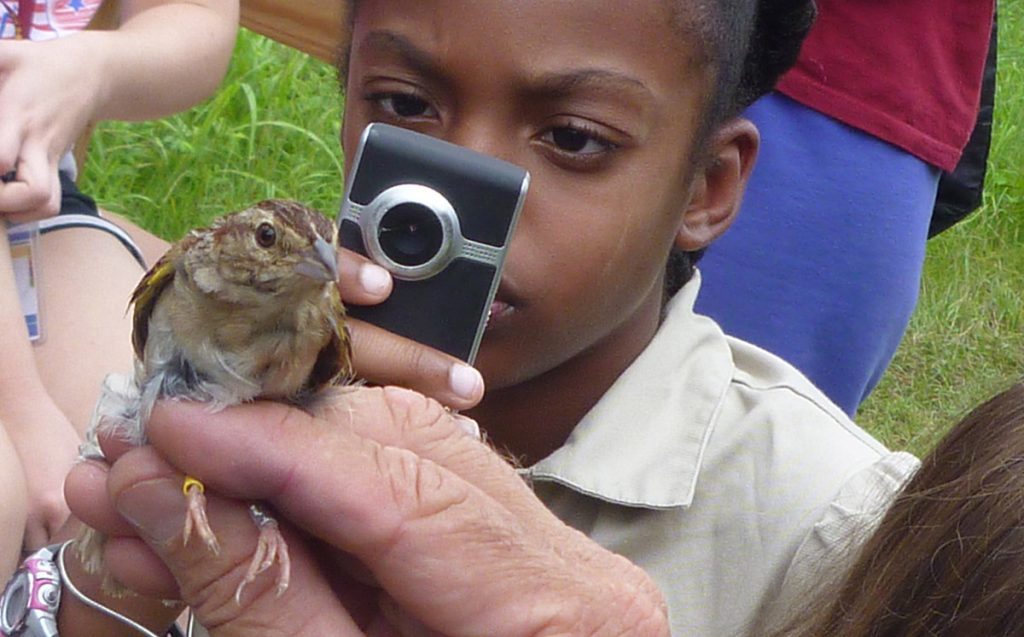
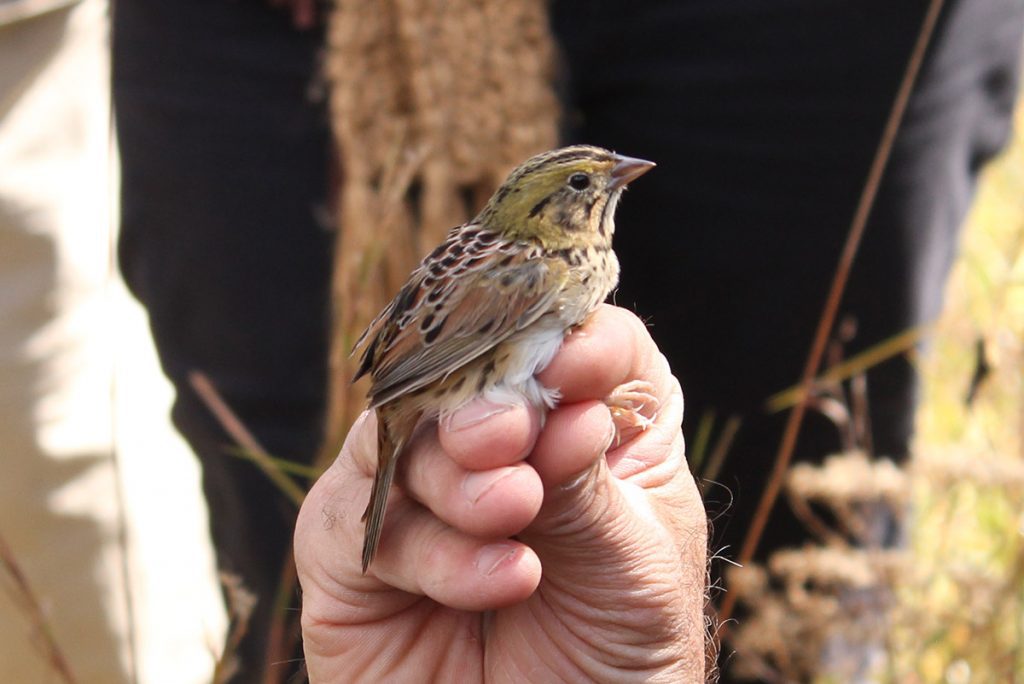
Jim clamps three bands on the legs of each bird. The first is a numbered metal band provided by the US Geological Survey to Federally permitted bird banders. For every bird Jim bands, he submits information to a national database. In this way, any bird banded anywhere can be observed by anyone, reported, and new information added about its life history.
Jim anodizes his USGS bands pink to visually distinguish them as having been banded at Tall Timbers. On the opposite leg, he adds two colored plastic bands. When he sees red-over-white or green-over-yellow up in a pine tree, he can look up the information he has already gathered about the bird, and add new information. In this way, he tracks which birds have left, and how far they went, and when they nest.
Nuthatch nest check
Jim has been checking nests for a couple of weeks before our early April visit. This is the only time of year that brown-headed nuthatches nest.
“The key thing with this bird is trying to nest early,” Jim says. “It can help it avoid snakes because when it’s cool, the snakes aren’t out running around. But after it becomes warm, the snakes come out.”
Because their nests are so low, nestlings would be an easy meal for a grey or red rat snake, which are common on Tall Timbers. Sometimes Jim finds a rattlesnake inside a nest with several lumps in its gut. He says that snakes are the number one cause of mortality for nestlings and females. Temperatures vary from year to year, but in early April, it’s usually cool enough for snakes to not be as active.
The nuthatches will stay in the nest about eighteen days. As Jim checks nests, he points out differences in birds born just a few days apart. Many nests have eggs hatched as much as a day-and-a-half apart from one other. This is an asymmetrical nest, where if they’d all hatched at about the same time, they’d be considered symmetrical.
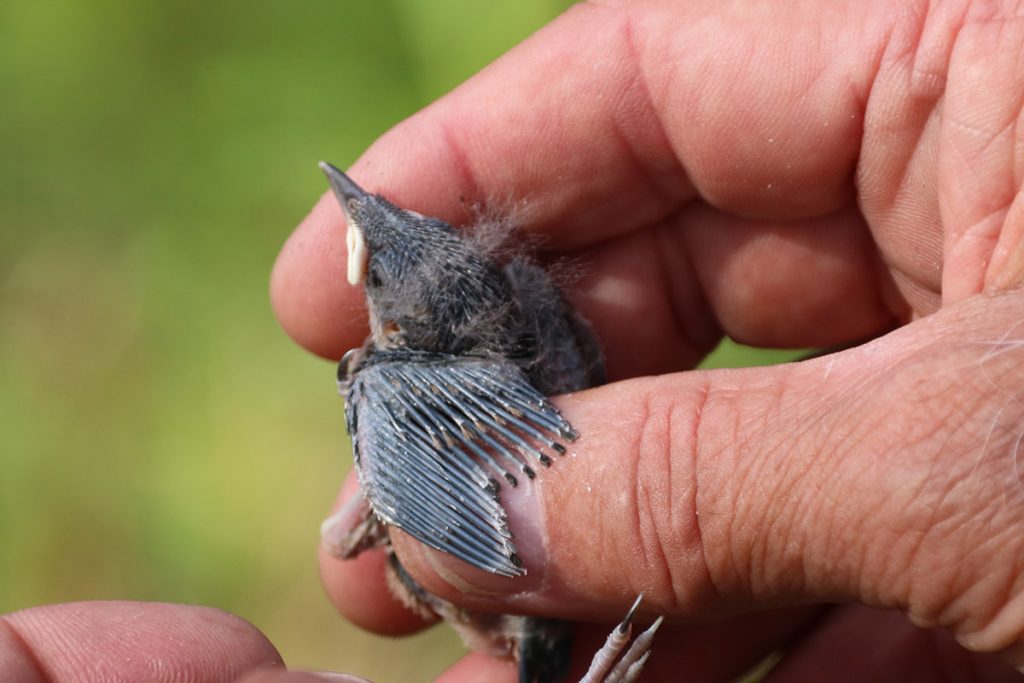
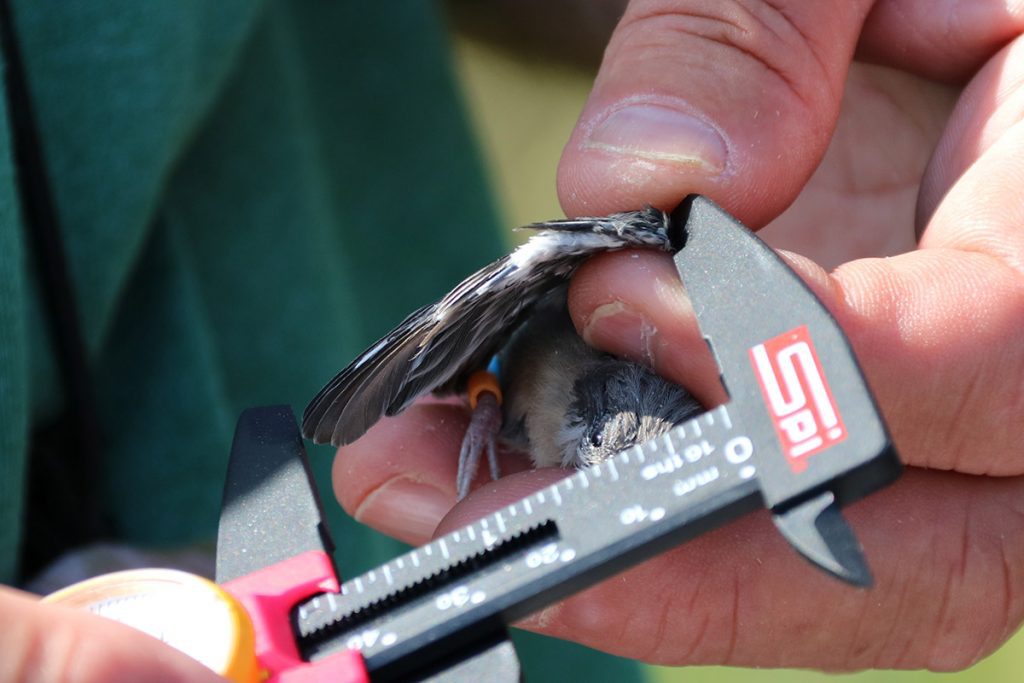
At day ten, the quills of the feathers are just emerging from their sheaths. These birds are too young for banding. Just three days later, you can see how the feathers have developed. The bird’s legs are now large enough for the bands it will wear the rest of its life.
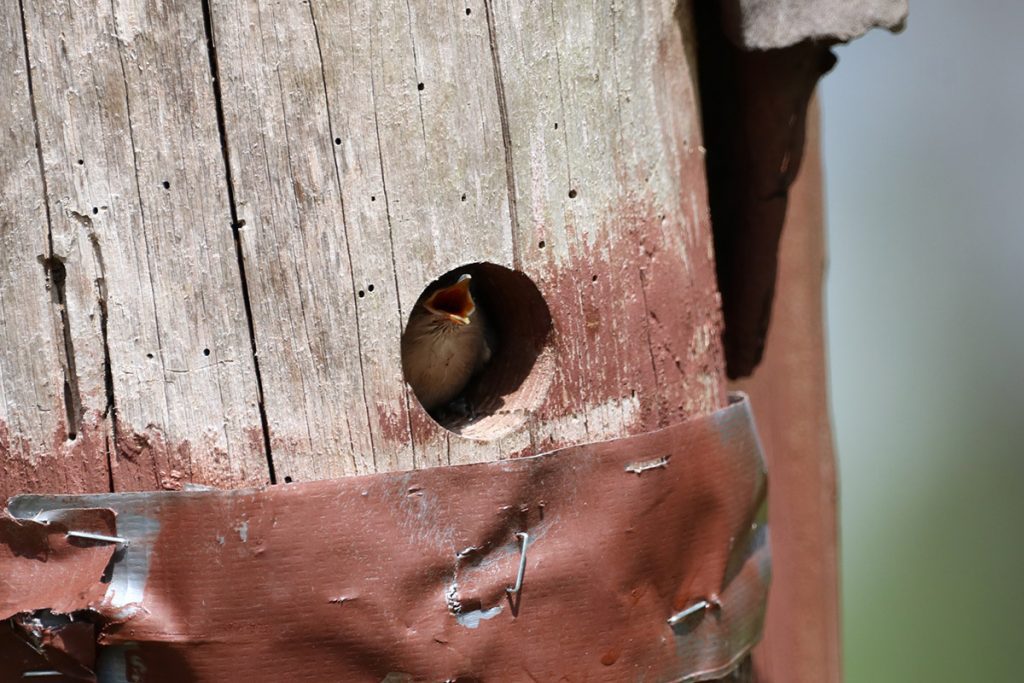
A nuthatch fledges, and…
We drive up to the last nest of the day. Like many of the nests we’ve seen, it’s an artificial nest. With a removable front panel, the chicks are easier for Jim to access. Brown-headed nuthatches will make new cavities every year, taking about a week-and-a-half to eight weeks to chisel the soft, decaying wood of a dead tree stump with their sharp little beaks. Artificial nests save them time as well.
As we pull up, we see a bird fly out of the nest. We just witnessed it fledge, Jim tells us. He checks the nest and sees one more that looks ready to go. I set up a camera on a tripod and point at its little head as it pops out of the opening. We sit and wait for about twenty or thirty minutes. A parent occasionally checks in on the nest, and nuthatches are calling their rubber-ducky calls in the trees above. Eventually, the bird peeps out one last time, and takes the plunge.
This last nuthatch is now out in the world, and it has choices to make. What will guide those choices?
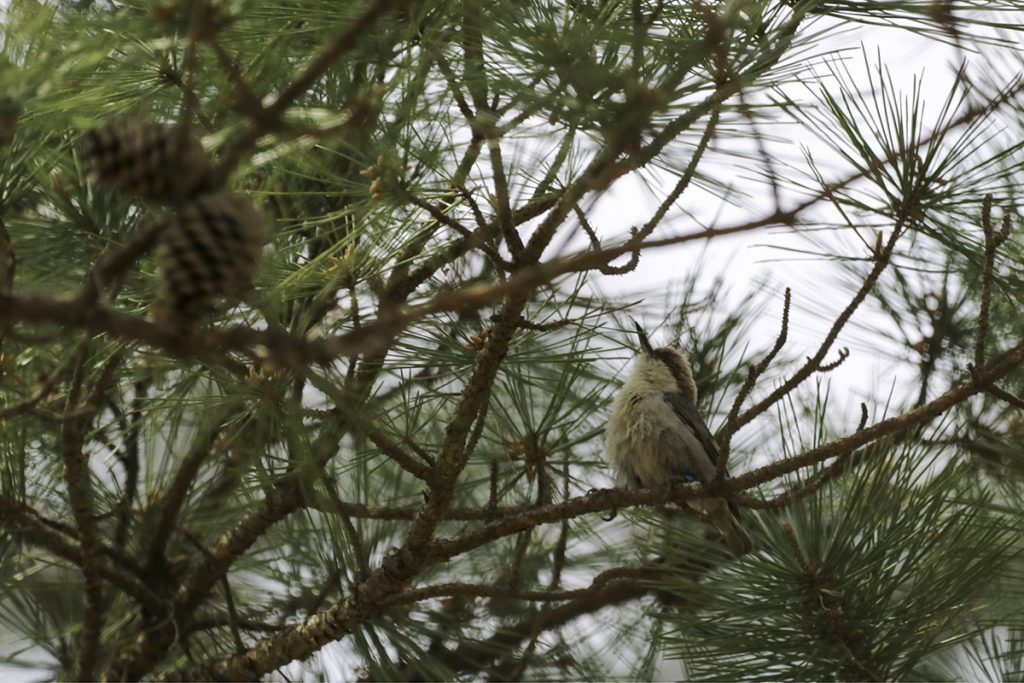
A few factors that may guide a nuthatch’s choice to stay or go.
Over the course of our visit, we’ve received a couple clues that may provide insights into how a nuthatch decides what to do after fledging.
1. Which leaves first, the big aggressive nestling, or its smaller, docile sibling?
One clue we see is on the bed of Jim’s pickup truck, where he weighs, measures, and bands the birds. Some thrash around– assertive, aggressive. Others are docile. You might think the docile birds would be more likely to be the ones to stick with the parents longer, but that’s not necessarily the case.
Let’s revisit the idea of an asymmetrical nest. One bird may be a full day ahead developmentally, and it will outcompete its slightly younger siblings for food. It’s larger, well fed, and more energetic. Jim says the smaller birds have higher stress hormone levels, as they’re less well fed. They’re struggling in the nest. This may prompt them to find a better situation.
“Distressed males, for example, tended to disperse,” Jim says. “All the females disperse generally. But then the males that were better provisioned there in the nest stayed and held on and became helpers.”
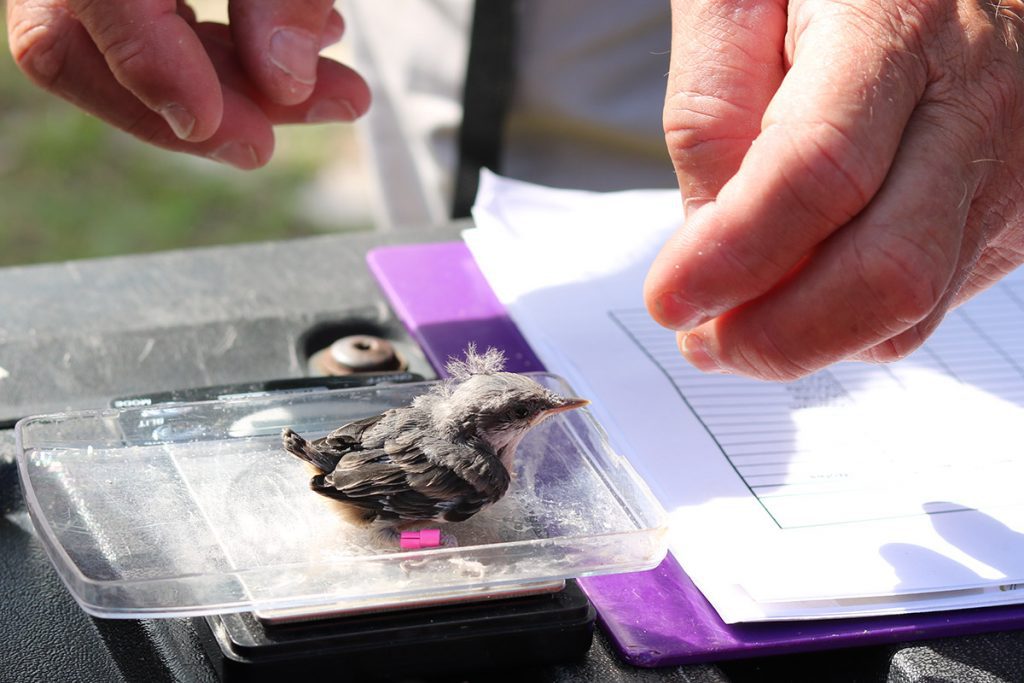
Males who had a better time in the nest stay with the family, while those that struggled have incentive to find a new situation. Females, though, all left. Which leads us to clue number two:
2. There are more male brown-headed nuthatches than females
Earlier, Jim told us that snakes are the number one cause of mortality in nuthatch females. This may be the reason that males outnumber females in their study population.
“Basically in our population, for every 100 females there are about 125 males,” Jim says. That’s a ratio of five males for every four females. “That excess of males is one thing that we think drives, in part, the cooperation.”
A male leaving the nest will have to compete for females. It may be more attractive for them to stay with the family group for another year than to strike out and perhaps end up alone and mateless. And yet the males who strike out first aren’t the biggest and strongest. How do they fare out in the forest? Do they thrive and find mates, or do they continue to struggle?
To answer these and other questions, Tall Timbers has been conducting experiments.
“We really did some neat, really neat work that has been drawing a lot of attention to this nuthatch population,” Jim says. “So we’re actually doing some manipulations where we’re trying to adjust the sex ratios to see what affect that have on the cooperative breeding behavior.”
So if there were more females in comparison to males, would males still stay?
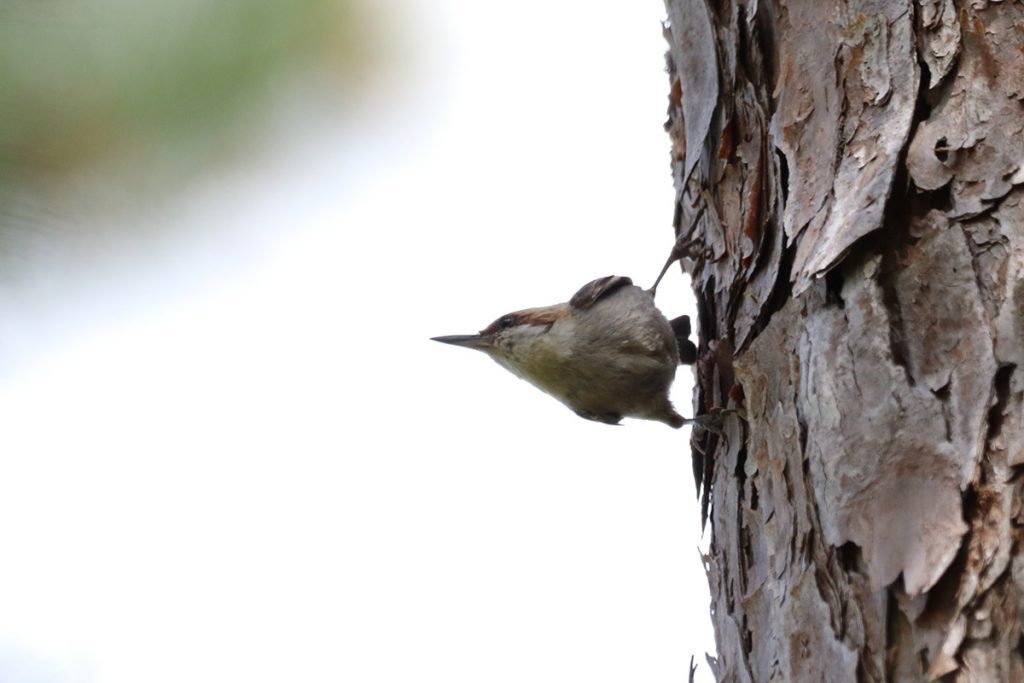
A little more about the brown-headed nuthatch
Jim Cox and the rest of the Stoddard Bird Lab have spent a lot of time examining the inner workings of cooperative breeding. And they have found out a bit about it. But there’s more to brown-headed nuthatches.
For one, they use tools. Nuthatches forage for insects high up in pine trees, probing the bark with their sharp beaks. Sometimes, they’ll use a piece of bark to loosen and remove other flakes of bark, exposing the insects below.
Like any plant, a longleaf pine tree is an ecosystem unto itself, and that bark contains its own food web. From that, nuthatches find spiders, bark beetle larvae, cockroaches, and more.
Jim points out that most birds forage a tree moving in one direction, “like sitting on top of a limb or clinging on to the side of a tree.” Nuthatches, however, “go sideways, upside down. They really spin around sort of like arboreal acrobats that are gymnasts up in the tops of the limbs, and they scurry around looking underneath… the side of a tree. And so they’re really acrobatic foragers.
“The other thing that I think kind of triggers a sort of a cute idea with the birds that they have a big head relative to their body, and it sort of reminds you of infants.”
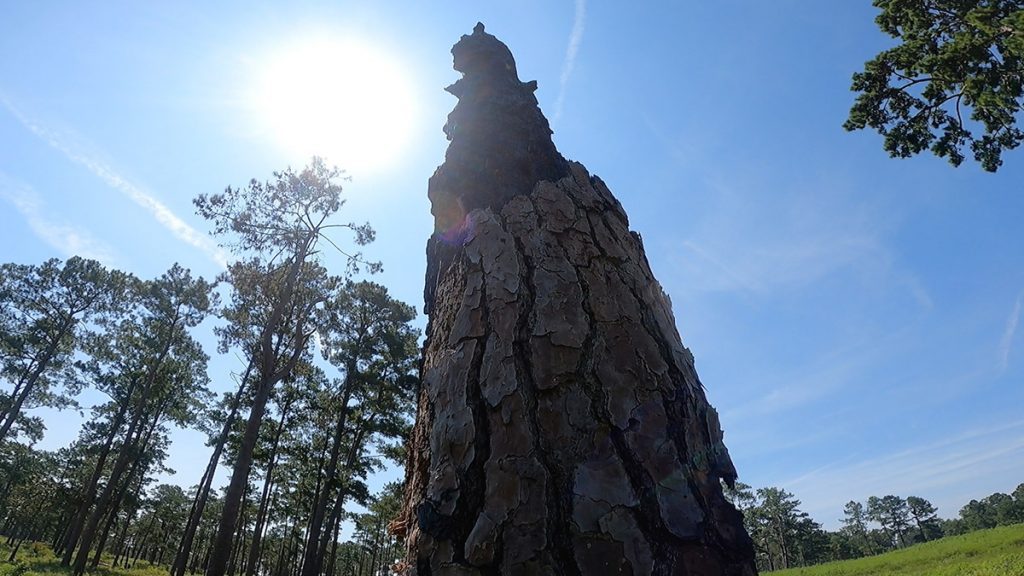
Once again: “One of the most important trees in the forest is a dead tree.”
That quote is from a segment on nesting bees, told to us by Native Nurseries of Tallahassee owner Elizabeth Georges. That big head on a brown-headed nuthatch, along with its sharp beak, makes it an expert excavator of the soft wood of a dead tree.
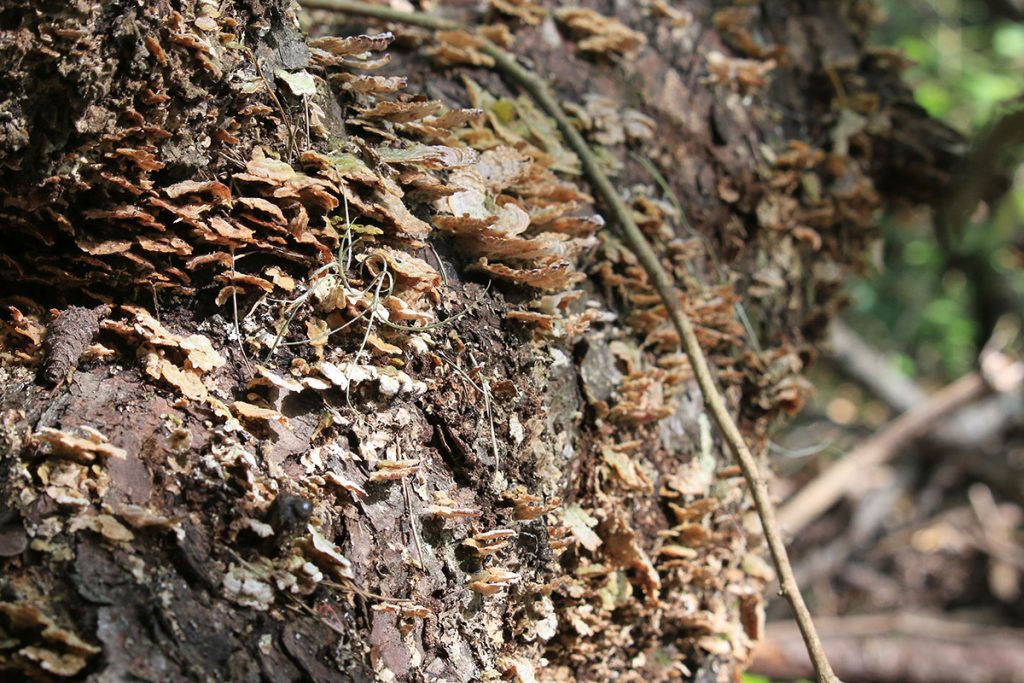
A dead, standing tree is a called a snag. Any dead tree, whether standing or lying on the forest floor, becomes a habitat for life of every kind. Fungi starts to eat away the cellulose that holds together the structure of wood, creating displays of mushrooms that grow from the trunk. Insects, from bees to beetles, riddle the wood with nests and tunnels which aerate the wood and further its decomposition. Insects and slugs eat the mushrooms as well.
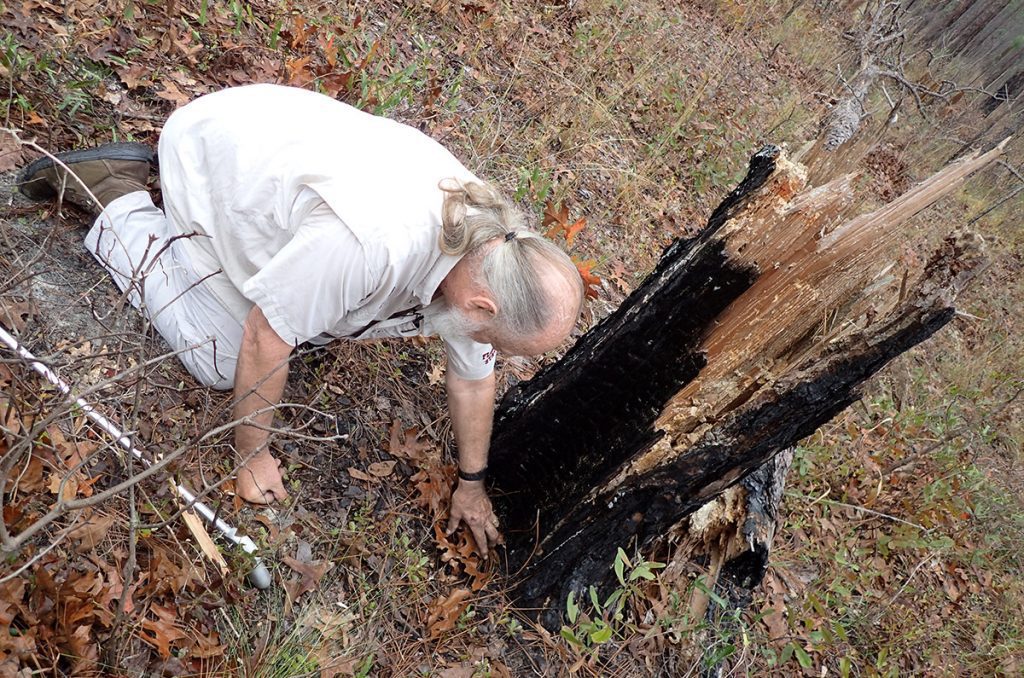
While at Tall Timbers, Dr. Bruce Means started studying the most venomous snake in North America, the eastern diamondback rattlesnake. He found that they often burrowed into the soft wood of dead pine stumps.
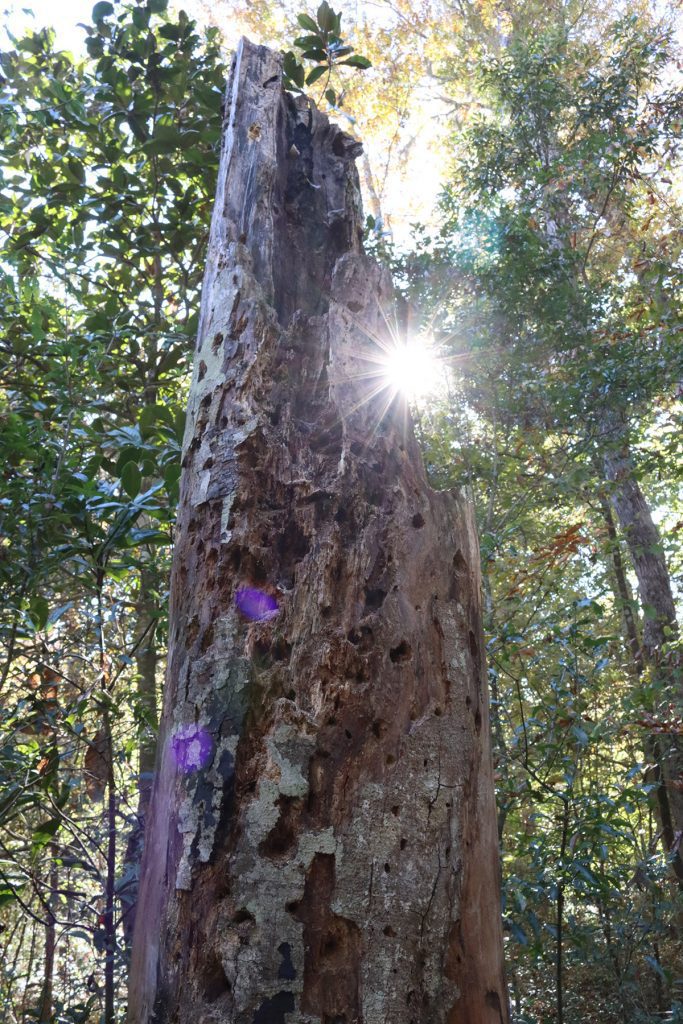
Snags are where every North American woodpecker makes its nest– with the exception of the red cockaded woodpecker. Like the brown-headed nuthatch, they provide a service for other animals in the forest. As Jim told me when I started waxing about the importance of snags:
“Well, leaving snags is great, but also having excavators is important, too.”
Not every bird is built to excavate a cavity in wood, but many of them do like to nest in cavities.
“After [nuthatches have] fledged young,” Jim says, “other species that use these nests, include eastern bluebird, Carolina chickadee, tufted titmouse. We’ve even had some downey woodpeckers and even white breasted nuthatches.”
In the video at the top of this page, you can see various clips provided to me by Jim of nest cavities he recorded at Tall Timbers. Bluebirds frequently flew up to nuthatch nests, even when they were occupied.
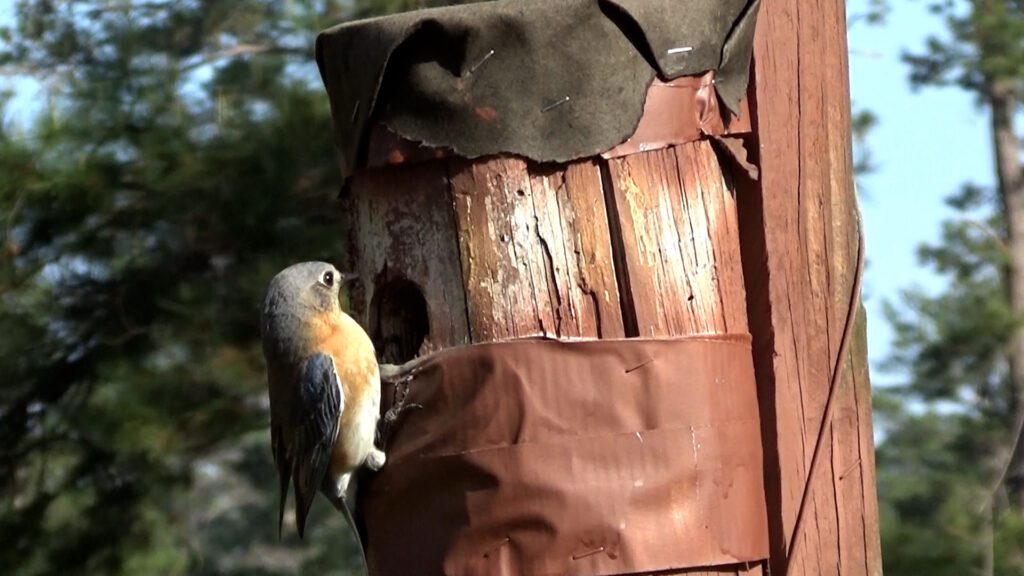
Red cockaded woodpeckers provide the same service to their fellow birds. “Fifteen years ago, we reintroduced the red cockaded woodpecker to Tall Timbers, [and] it created cavities that are used by other species. And we’ve seen upticks in some of those species, such as white breasted nuthatch, northern flicker, and redheaded woodpecker that use the red cockaded cavities.”
Neither compares to the gopher tortoise when it comes to building a habitat for other animals in a longleaf ecosystem. Burrow and cavity makers are a critical part of this habitat, without which other animals would not have places to shelter and nest.
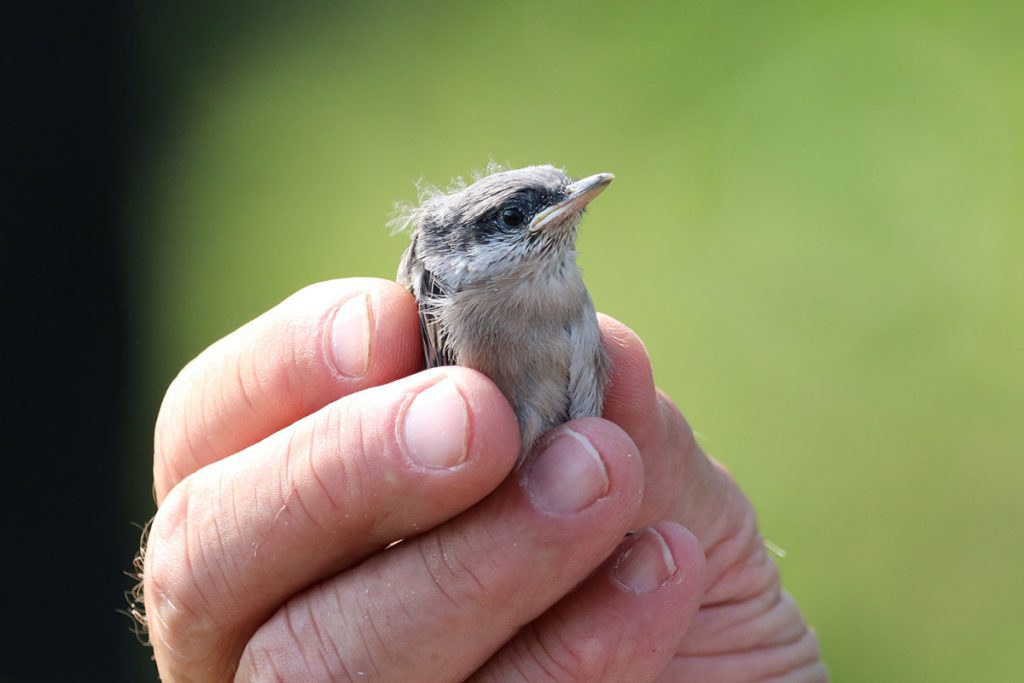
Five thousand nuthatches and counting
Jim Cox estimates that Tall Timbers has banded about 5,000 brown-headed nuthatches over the course of the study, averaging about 200 nestlings a year. He says he didn’t start banding every nestling he could until he was a few years into the research. At a certain point, he felt that he needed to be better able to track how far they dispersed across the property, and so he needed to know as many of the birds as possible.
Tall Timbers Research Station provides 2,800 acres of habitat for Jim and the other staff biologists to conduct long term studies. Many are focused on the ecology of fire, and how an ecosystem responds to fire applied in different ways, or not at all. Other research focuses on endangered animals such as red cockaded woodpeckers, or commercially important game animals such as bobwhite quail.
Brown-headed nuthatches are neither imperiled nor commercially important. They’re birds with an interesting family life, and with choices to make. They’re the type of bird you might study if you love learning about birds.
“I’ve always enjoyed watching birds, all my life,” Jim says. “It wasn’t until I actually graduated with English and history degrees that I realized I didn’t like working at a newspaper, and I didn’t like doing the jobs that were available for that. And I went back. I had done a lot of work to get towards a biology minor, but then I went back into graduate school and completed a graduate degree in biology.”
